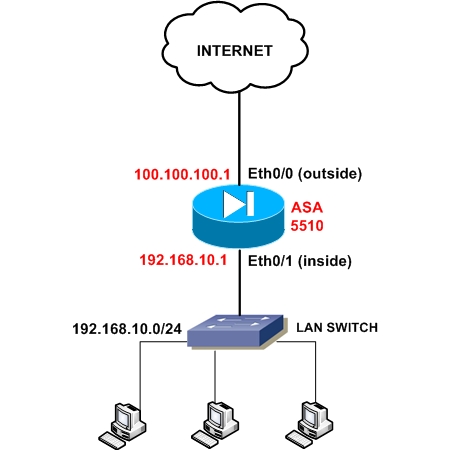Next we will see a simple Internet Access scenario which will help us to understand the basic steps needed to setup an ASA 5510. Assume that we are assigned a static public IP address 100.100.100.1 from our ISP. Also, the internal LAN network belongs to subnet 192.168.10.0/24. Interface Ethernet0/0 will be connected to the outside (towards the ISP), and Ethernet0/1 will be connected to the Inside LAN switch. Refer to the diagram below for our example scenario.
The firewall will be configured to supply IP addresses dynamically (using DHCP) to the internal hosts. All outbound communication (from inside to outside) will be translated using Port Address Translation (PAT) on the outside public interface. Let’s see a snippet of the required configuration steps for this basic scenario:
Step1: Configure a privileged level password (enable password)
By default there is no password for accessing the ASA firewall, so the first step before doing anything else is to configure a privileged level password, which will be needed to allow subsequent access to the appliance. Configure this under Configuration Mode:
ASA5510(config)# enable password mysecretpassword
Step2: Configure the public outside interface
ASA5510(config)# interface Ethernet0/0
ASA5510(config-if)# nameif outside
ASA5510(config-if)# security-level 0
ASA5510(config-if)# ip address 100.100.100.1 255.255.255.252
ASA5510(config-if)# no shut
Step3: Configure the trusted internal interface
ASA5510(config)# interface Ethernet0/1
ASA5510(config-if)# nameif inside
ASA5510(config-if)# security-level 100
ASA5510(config-if)# ip address 192.168.10.1 255.255.255.0
ASA5510(config-if)# no shut
Step 4: Configure PAT on the outside interface
ASA5510(config)# global (outside) 1 interface
ASA5510(config)# nat (inside) 1 0.0.0.0 0.0.0.0
UPDATE for ASA Version 8.3
From March 2010, Cisco announced the new Cisco ASA software version 8.3. This version introduced several important configuration changes, especially on the NAT/PAT mechanism. The “global” command is no longer supported. NAT (static and dynamic) and PAT are configured under network objects. The PAT configuration below is for ASA 8.3 and later:
object network obj_any
subnet 0.0.0.0 0.0.0.0
nat (inside,outside) dynamic interface
Step 5: Configure Default Route towards the ISP (assume default gateway is 100.100.100.2)
ASA5510(config)# route outside 0.0.0.0 0.0.0.0 100.100.100.2 1
Step 6: Configure the firewall to assign internal IP and DNS address to hosts using DHCP
ASA5510(config)# dhcpd dns 200.200.200.10
ASA5510(config)# dhcpd address 192.168.10.10-192.168.10.200 inside
ASA5510(config)# dhcpd enable inside
The above basic configuration is just the beginning for making the appliance operational. There are many more configuration features that you need to implement to increase the security of your network, such as Static and Dynamic NAT, Access Control Lists to control traffic flow, DMZ zones, VPN etc. I just tried to offer you a starting point for a basic configuration from where you can build your knowledge further.

1 comment:
So are you doing an "permit ip any any" on both inside and outside interface? I noticed you don't mention any ACLs besides the NAT.
Post a Comment